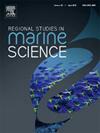Assessing changes between two years in macrobenthic invertebrate communities in four sub-tropical Australian estuaries
IF 2.1
4区 环境科学与生态学
Q3 ECOLOGY
引用次数: 0
Abstract
Estuaries provide critical ecosystem services but are threatened by natural and human pressures. Assessing their ecological condition is essential to evaluate future change. This study aimed to determine the biodiversity of macrobenthic invertebrates and potential environmental drivers in four estuaries between two timepoints. Following the significant 2022 flood events on the north coast of NSW Australia, we used benthic cores to sample the macrofauna in 2023, replicating a baseline survey undertaken in 2007. Four replicate samples were taken at three tidal heights (all <1 m) on sand banks in the mid-estuary zone at Brunswick, Sandon, Corindi and Bellinger Rivers. Benthic macroinvertebrates (>1 mm) were sorted, identified, counted and categorised into functional groups. The abundance and species richness was significantly lower in 2023 compared to 2007. Macrobenthic diversity and community composition showed significant variation between years, among estuaries. The bivalve Mysella vitrea (Lasaeidae) was the most abundant species, primarily explaining the dissimilarity between years. Deposit feeders dominated the functional groups, but their percentage was lower in 2023 compared to 2007. Differences in the environmental condition at the sites between two years reflect higher rain run-off in 2023, including significantly lower salinity and higher turbidity. Distance-based linear modelling showed that turbidity correlated significantly with the changes in community structure at the family level. The BEST model included a mix of physicochemical parameters, turbidity and % organic matter and explained 94.8 % of the variation in community structure, suggesting that freshwater and sediment run-off may influence macrobenthic communities in these estuaries. Results from this study support previous findings highlighting the problem of lack of data to document shifting baselines and the need for regular monitoring of estuarine ecosystems.
求助全文
约1分钟内获得全文
求助全文
来源期刊

Regional Studies in Marine Science
Agricultural and Biological Sciences-Ecology, Evolution, Behavior and Systematics
CiteScore
3.90
自引率
4.80%
发文量
336
审稿时长
69 days
期刊介绍:
REGIONAL STUDIES IN MARINE SCIENCE will publish scientifically sound papers on regional aspects of maritime and marine resources in estuaries, coastal zones, continental shelf, the seas and oceans.
 求助内容:
求助内容: 应助结果提醒方式:
应助结果提醒方式:


